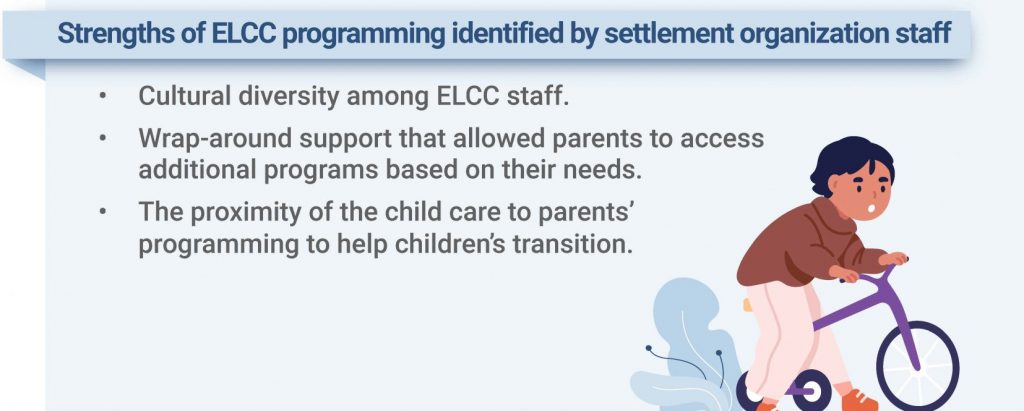Mobilizing Innovative Models in Early Childhood Education and Care for Newcomer Families and Children
Researchers: Jessie-Lee McIsaac1, Nahal Fakhari1, Milena Pimentel1, Nickolas Hickens1, Heather Podanovitch1, Emma Coughlan1, Nabiha Atallah1, Gina Moynan2, Tayitu Sebsibie2
Affiliation: Early Childhood Collaborative Research Centre (ECCRC) Mount Saint Vincent University1, Immigrant Services Association of Nova Scotia (ISANS)2
Research Partner: ISANS
Keywords: Early learning, child care, early childhood education (ECE), settlement agencies, newcomer children, newcomer families, social and emotional development
Jump to: Full infographic, Methodology, Findings, Recommendations, Publications & Reports
Summary
Overview: This study explored current early learning and child care (ELCC) programs available to newcomer families to better understand what is needed to meet the unique social and emotional learning needs of newcomer children.
Objective: to describe how ELCC is implemented through settlement agencies in Canada and identify innovative approaches to programming.
Research Justification: High-quality ELCC programs are positioned to support newcomer family settlement, reduce socio-economic inequalities, and enhance children’s social and emotional development and language acquisition. However, there is limited research that has explored how ELCC is delivered to newcomer families.
Methodology
The research team conducted a website scan of settlement organizations, sent out surveys, and invited key informants to participate in interviews. Overall, 38 organizations participated; all were English-speaking programs. Not all participating programs were IRCC-funded or followed Childminding, Monitoring, Advisory and Support (CMAS) requirements – the guidelines followed by IRCC funded Care for Newcomer Children (CNC) programs. Twenty-three programs only received IRCC funding, 12 received IRCC and additional funding (e.g., provincial, municipal, community), and 2 did not receive IRCC funding. Twenty-nine programs followed CMAS requirements, 2 programs had some services that followed CMAS requirements, and 5 programs did not follow CMAS requirements.
Interviews with settlement organizations provided additional information on their ELCC programs and their perspectives on the experiences of newcomer families. A thematic analysis identified the perceived strengths, perceived challenges, and innovative approaches that influence the accessibility, inclusion, and quality of ELCC programs.
Findings
Perceived Strengths:
- Participants felt that cultural diversity among staff was important for informing a deeper awareness of the needs of newcomer families and providing a culturally responsive and inclusive environment.
- They felt the educators delivering the programs were knowledgeable, experienced, qualified, and dedicated.
- Providing wrap-around support so that newcomer families could access child care and additional programs based on their needs was beneficial.
- The proximity of the child care to the parents’ program (e.g., language instruction) helped children’s transition.
Perceived Challenges:
- The variety of families’ language needs was a challenge for educators to ensure families had all the information they needed.
- Trauma and pre-migration experiences caused children and parents to feel distress about separating for child care.
- A lack of outdoor space prevented children from exercise their gross motor skills.
- A lack of physical space limited programs’ ability to take on more families.
- Insufficient funding created barriers for programs to access specialized support, offer fair compensation for their educations, and access professional development (e.g., trauma-informed care).
- Not being provincially licensed prevented programs from accessing provincial funding, inclusion support, and development/ intervention services.
Innovative Models:
- Partnerships with school district, settlement department, other child care programs, and other licensing bodies helped improve the accessibility and awareness of the program and provide additional supports for families.
- An organizational commitment to trauma-informed care and specifically seeking out professional development for staff on this topic led to more empathetic care.
- Despite not having an outdoor playground, one organization intentionally supported children’s gross motor skills through the use of toys and equipment such as compact tunnels and balancing beams.
Recommendations
- Advocates should continue to shift the framework from child minding to early learning to support programs and contribute to the professionalization of ELCC across the country. They should also emphasize the crucial role of child care as an essential settlement program to improve access to services for newcomer families.
- Policy makers should enable partnerships between ELCC programs and other organizations by creating new opportunities and funding through the Canada-Wide Early Learning and Child Care agreements.
- Policies and programs are needed to support early childhood educators through professional learning and fair compensation. Enabling educators to access a range of professional learning opportunities can help them provide trauma-informed care and can help newcomer educators get formally accredited.
Explore more projects



